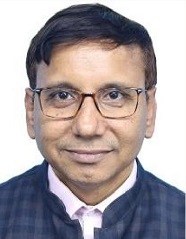
Prof. Balaram Kundu
Jadavpur University, India
Title: Non-Fourier model for enhancement of heat transfer through fins
Abstract:
Personal computer performance improves rapidly due to the development of the microprocessor unit and graphics processor unit. This improvement causes a rapid increase in heat generation density. The heat generation density of these processors exceeds that of an electric hot plate. The rapid increase in heat generation, accompanied by the rise in temperature, limits the performance of the processor units and the electronic equipment itself. One method for optimization of the cooling process is the addition of fins at the heat transfer surface. Fins enhance the heat exchange rate from heated surfaces to avoid unwanted high temperatures. Adding fins increases the effective heat transfer area, reducing the base surface temperature for a given heat load and heat transfer coefficient. Because of their wide-ranging applications, analyzing heat generation in fins is very important. The fin analysis is generally based on the classical Fourier law of heat conduction. The limitation of this law is that the speed of propagation of thermal waves is considered infinite. Hence, the actual speed is a finite value, especially in the case of very high-temperature gradients, tiny structural dimensions, and very low temperatures. Efforts are dedicated to eliminating the paradox of an infinite thermal wave speed, which contradicts Einstein's theory of relativity. Cattaneo [1] and Vernotte [2] independently postulated a time-dependent relaxation model for the heat flux in solids, known as the non-Fourier model, to eradicate this paradox. This model was first proposed by Maxwell [3] and provides a theory to explain the experimental data on 'second sound' in liquid and solid helium at low temperatures. The keynote speech will describe an analytical model to determine the temperature response in the fin non-Fourier heat transfer mechanisms, the instantaneous fin efficiency of the longitudinal and pin fins, the effects of boundary conditions, the intensity of heat generation, Fourier number, and Vernotte number on the fin's temperature distribution. A comparative result understands how the non-Fourier model deviates from the Fourier model. This difference is significant for the lower value of the Fourier and higher value Vernotte numbers. The non-Fourier heat transfer dominates as the intensity of the internal heat generation increases and is dependent upon the boundary conditions.
References
[1] C. Cattaneo, Sur une forme de l’equation de la chaleur elinant le paradoxe d’une propagation instantance, C.R. Acad. Sci. 247 (1958) 431–432.
[2] P. Vernotte, Les paradoxes de la theorie continue de l’equation de la chaleur, C.R. Acad. Sci. 246 (1958) 3154–3155.
[3] J.C. Maxwell, On the dynamic theory of gases, Philos. Trans. R. Soc. London 157 (1867) 49–88.
Biography:
Prof. Kundu graduated in Mechanical Engineering from Regional Engineering College Durgapur (Presently NIT Durgapur) in 1993 and post-graduated in Thermal Engineering from Bengal Engineering College Shibpur (Deemed University) (presently IIESTS) in 1995. He received his Ph.D. in Mechanical Engineering from the Indian Institute of Technology, Kharagpur, India, in 2000. His international journey began with a one-month visit to Saga University, Japan, as a Visiting Faculty in 2007 (November-December). He then served as a Research Professor at the School of Mechanical Engineering at Hanyang University, Seoul, South Korea, for two years and nine months under the Brain Korea 21 program (01.01.2010–27.09.2012). His global engagement continued with multiple visits to Hanyang University as a Visiting Research Professor. He has also conducted collaborative research in various countries such as Japan, South Korea, the USA, Thailand, Turkey, etc., showcasing his global perspective and potential for collaboration.